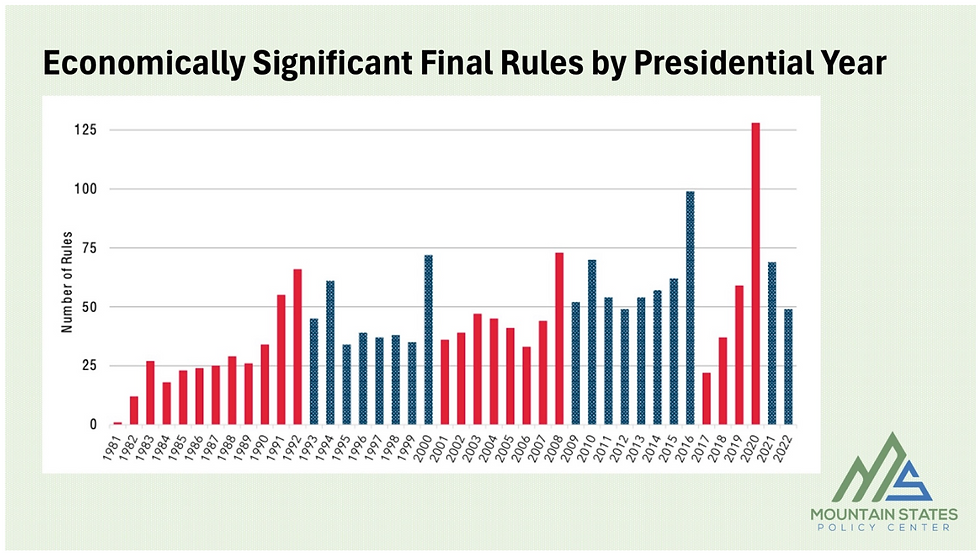Like it or not, regulations play a role in our everyday lives. Some dictate where and how we can eat. Others place restrictions on what we can sell or how we can operate a business.
For example, in Tamarack, Idaho, it was once illegal to buy onions after dark without a permit. Nationally, 18 U.S. Code 2074 makes it a crime to “knowingly issue or publish any counterfeit weather forecast.” Bacon processing plants in California still require a fax machine.
Today, we are releasing a new publication: Pillars of regulatory reform and oversight. We hope it will be a tool for lawmakers, media and citizens to ensure the lightest regulatory touch.
Whether they be at the local, state, or federal level, all laws and regulations have a cost. In fact, a study by the Journal of Economic Growth concluded that regulations have slowed economic growth by as much as two percent per year. Economists at the Mercatus Center at George Mason University found the size of the regulation state significantly slows economic growth and has translated into a $13,000 loss in real income for every American.

Rules and regulations come in all shapes and sizes. They can be tallied by pages, words, and even economic significance. Luckily, policymakers in the Mountain States have recognized the need to limit the regulatory burden. Idaho Governor Brad Little has touted his Red Tape Reduction Act – an effort to make Idaho one of the least regulated states in the nation. Numerous national reports give Idaho top marks for the effort.
Montana Governor Greg Gianforte has labeled red tape reduction as one of his top priorities. In the most recent Montana legislative session, he signed into law more than 100 bills to eliminate commissions, streamline applications, and do away with burdensome and outdated requirements.
These efforts should not be confused with an attempt to do away with every law, rule, and regulation. On the contrary, those that are well-designed and consistently reviewed protect not only business owners and workers but also consumers and citizens. Still, lawmakers in the region and across the nation can and should do more. Thousands of rules and regulations no longer relevant or needed remain on the books.
As policymakers consider the rules that govern rules and regulations, they should take care to ensure they are simple, predictable, and reviewable.
The fight to reduce ineffective and burdensome regulations has received the most traction at the state level. In 2023 alone, Idaho legislators have reviewed more than 120 new or updated rules from state bureaucracy, on topics including daycare licensing, bail agents, insurance fees, corporate governance, juvenile detention centers, podiatry, physical therapy, invasive species stickers, and more.
Idaho started on the path to its low regulatory burden with Governor Brad Little’s Red Tape Reduction Act. It continued its effort with zero-based regulation – an executive order that forces regular reviews of rules and restrictions. In fact, roughly 20% of each of Idaho’s agency rules are reviewed annually.

At the state level, policymakers should be doing more to reduce burdensome regulations and take responsibility for those still on the books. Perhaps the best way to accomplish this goal is to be committed to the separation of powers. In too many cases, bureaucrats take on the role of rulemaking and implementation – even though they were never elected to write laws. Legislatures should never delegate sweeping lawmaking authority to regulatory agencies.
Executives have the responsibility of signing and implementing laws, and any rule that has the force of law should be signed by the Governor. Far too often, state rules are signed and put into place by unelected bureaucrats who may not need to consider the best interests or concerns of citizens because citizens cannot remove them from office. It is more difficult for a state’s chief executive to claim he or she didn’t know about a controversial rule if they were required to approve the rule before it took effect.
Judges are constitutionally required to interpret the law without bias. Unfortunately, many judges have decided to defer their role and responsibilities to agency interpretation. To ensure the judiciary understands and doesn’t skirt its duty, judges should interpret statutes, regulations, and other documents without giving any deference to an agency’s legal interpretation. If the text is still unclear, judges should default to a reasonable interpretation that limits agency power and maximizes individual liberty. In other words, the tie should go to the citizen, not the government.
Thanks to the separation of powers, ensuring oversight and lessening the regulatory burden are achievable. Each of the three branches has a role and responsibility. As the National Governors Association writes, “well designed regulations protect workers, consumers and the environment while promoting entrepreneurship and economic growth.”
Idaho and Montana deserve credit for attempting to reform the regulatory state. But as new policymakers consider the rules that govern rules and regulations, they should take care to ensure they are always simple, predictable, and reviewable. Policymaking is the exclusive prerogative of the legislative branch of our government and should never be delegated to an unelected administrative body.





